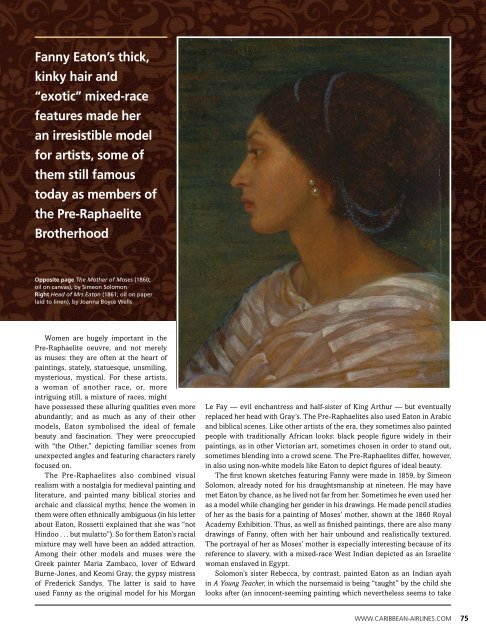Caribbean Beat — January/February 2017 (#143)
A calendar of events; music, film, and book reviews; travel features; people profiles, and much more.
A calendar of events; music, film, and book reviews; travel features; people profiles, and much more.
You also want an ePaper? Increase the reach of your titles
YUMPU automatically turns print PDFs into web optimized ePapers that Google loves.
Fanny Eaton’s thick,<br />
kinky hair and<br />
“exotic” mixed-race<br />
features made her<br />
an irresistible model<br />
for artists, some of<br />
them still famous<br />
today as members of<br />
the Pre-Raphaelite<br />
Brotherhood<br />
Opposite page The Mother of Moses (1860;<br />
oil on canvas), by Simeon Solomon<br />
Right Head of Mrs Eaton (1861; oil on paper<br />
laid to linen), by Joanna Boyce Wells<br />
Women are hugely important in the<br />
Pre-Raphaelite oeuvre, and not merely<br />
as muses: they are often at the heart of<br />
paintings, stately, statuesque, unsmiling,<br />
mysterious, mystical. For these artists,<br />
a woman of another race, or, more<br />
intriguing still, a mixture of races, might<br />
have possessed these alluring qualities even more<br />
abundantly; and as much as any of their other<br />
models, Eaton symbolised the ideal of female<br />
beauty and fascination. They were preoccupied<br />
with “the Other,” depicting familiar scenes from<br />
unexpected angles and featuring characters rarely<br />
focused on.<br />
The Pre-Raphaelites also combined visual<br />
realism with a nostalgia for medieval painting and<br />
literature, and painted many biblical stories and<br />
archaic and classical myths; hence the women in<br />
them were often ethnically ambiguous (in his letter<br />
about Eaton, Rossetti explained that she was “not<br />
Hindoo . . . but mulatto”). So for them Eaton’s racial<br />
mixture may well have been an added attraction.<br />
Among their other models and muses were the<br />
Greek painter Maria Zambaco, lover of Edward<br />
Burne-Jones, and Keomi Gray, the gypsy mistress<br />
of Frederick Sandys. The latter is said to have<br />
used Fanny as the original model for his Morgan<br />
Le Fay <strong>—</strong> evil enchantress and half-sister of King Arthur <strong>—</strong> but eventually<br />
replaced her head with Gray’s. The Pre-Raphaelites also used Eaton in Arabic<br />
and biblical scenes. Like other artists of the era, they sometimes also painted<br />
people with traditionally African looks: black people figure widely in their<br />
paintings, as in other Victorian art, sometimes chosen in order to stand out,<br />
sometimes blending into a crowd scene. The Pre-Raphaelites differ, however,<br />
in also using non-white models like Eaton to depict figures of ideal beauty.<br />
The first known sketches featuring Fanny were made in 1859, by Simeon<br />
Solomon, already noted for his draughtsmanship at nineteen. He may have<br />
met Eaton by chance, as he lived not far from her. Sometimes he even used her<br />
as a model while changing her gender in his drawings. He made pencil studies<br />
of her as the basis for a painting of Moses’ mother, shown at the 1860 Royal<br />
Academy Exhibition. Thus, as well as finished paintings, there are also many<br />
drawings of Fanny, often with her hair unbound and realistically textured.<br />
The portrayal of her as Moses’ mother is especially interesting because of its<br />
reference to slavery, with a mixed-race West Indian depicted as an Israelite<br />
woman enslaved in Egypt.<br />
Solomon’s sister Rebecca, by contrast, painted Eaton as an Indian ayah<br />
in A Young Teacher, in which the nursemaid is being “taught” by the child she<br />
looks after (an innocent-seeming painting which nevertheless seems to take<br />
WWW.CARIBBEAN-AIRLINES.COM 75


















